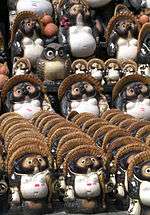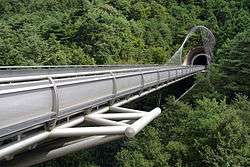Koka
Kōka (甲賀市) is a city in Shiga prefecture, Japan.
Understand
Kōka is well known for its ninja history (Kōga ninja clan), unique ceramics and position on the Tokaido Road. The Kōga ninja clan were rivals of the nearby Iga ninjas. Unlike the Iga ninja, whose power was well-known, the Kōga clan are said to have used stealth and deception to mask their size and power, creating fake rivals for themselves. In 1581, the two clans joined forces against Oda Nobunaga, but were defeated by Nobunaga's overwhelming forces, and the surviving members of the Kōga ninja went into retreat.
The ceramics produced in Kōka, known as Shigaraki-yaki, have been prized across Japan for centuries. Today you will see many small pottery shops lining the streets near Shigaraki Station.
The Tokaido Road was for centuries the main route from Kyoto to Edo (present day Tokyo). The road passes through the heart of Kōka, and two famous rest stations, Tsuchiyama and Minakuchi, are located here.
In 2004 the towns of Minakuchi, Shigaraki, Tsuchiyama, Kōka and Kōnan merged to form Kōka City. This is a rural area with few English speakers. Some Japanese language capability is needed to find sites.
Get in
Kōka has five stations on the JR Kusatsu Line. The largest station, Kibukawa, is about a 45 minute ride from Kyoto.
From JR Osaka or Kyoto Station, get on any regular, rapid or special rapid train headed for Kusatsu, Yasu, Maibara, Nagahama or Tsuruga. Get off the train at Kusatsu. From Kyoto this takes about 15-20 minutes. Do not exit Kusatsu station, and transfer to any train bound for Kibukawa or Tsuge (Keep in mind that trains bound for Tsuge will stop at all stations in Kōka City, while trains bound for Kibukawa will only stop at Kibukawa). The train from Kusatsu to Kibukawa takes about 25 minutes.
Get around
Along with the JR train line, Kōka has 4 stops on the Omi Railway and 5 stops on the Shigaraki Kogen Railway. Both of these railways can be accessed at JR Kibukawa Station. Kōka also has an extensive bus network, with many buses departing from Kibukawa Station.
See
- Ninja Village (忍術村) - Similar to the once hidden ninja villages that existed in the area, the Koka Ninja Village exhibits a number of transplanted ninja estates. With a plethora of contraptions and a throwing star training room, this is the place to go for a hands-on ninja experience. The attached museum offers an extensive 1,400 piece collection of ninja artifacts. Ninja uniforms are available for trying on and kids will enjoy the obstacle course of walls and ropes. Take the JR Kusatsu Line to Kōka station. There is free bus/minivan pickup from the station to the Ninja Village. (394 Oki Koka-cho, Koka-shi; 9:00am-5:00pm, closed Mondays and 12/27-1/1. Admission ¥1000 adults, ¥800 children ages 13-18, ¥700 ages 6-12, ¥500 ages 3-6.)
- Kōka Ninja Estate (甲賀流忍術屋敷) - This estate was built over 300 years ago for the famous ninja leader Mochizuki Izumonokami. From the outside, this estate looks the same as the other homes in the area, however the inside clandestinely reveals the characteristics of a ninja residence. You will see a number of trap doors, false walls and hidden rooms that were designed to protect the home from potential intruders, . You will have an opportunity to see a display of actual ninja weaponry and other historical artifacts, You can even take a try at throwing ninja stars. The gift shop sells small souvenirs, and everyone can sample a specially blended health tea that the ninjas often prepared. Take the JR Kusatsu line to JR Kōnan Station. The Ninja Estate is a 20 minute walk from the station. (Ryuhoji Kōnan-cho, Kōka-shi; 9:00am-4:30pm, closed 12/27-1/1. Admission ¥600 adults, ¥300 children ages 6-12.)

- Shigaraki-yaki Ceramics (信楽焼) - Shigaraki is home to one of the oldest and most famous schools of pottery in all of Japan. As you exit Shigaraki Station and walk along the main road, you will see dozens of small shops selling ceramics that range from ornamental to practical. "Shigaraki-yaki," as the pottery is known, was first produced in the Kamakura period during the 12th century. Several centuries later, during the Muromachi period, Shigaraki-yaki gained prominence as an ideal ceramic for the traditional Japanese tea ceremony. Recently, some of the most recognizable pottery from Shigaraki are tanuki (a racoon-like animal) statues. Of course cups, plates, bowls and a number of other goods are also available.
- Tsuchiyama Tokaido Museum (東海道伝馬館) - This Japanese style estate offers various displays and exhibits about the history of Tsuchiyama and the Tokaido Road. The Tokaido Road is the famous route that for centuries served as the main link between Kyoto and Edo (modern day Tokyo) The museum also offers hands on activities and a small shop selling locally made goods.
- Minakuchi Castle (水口城) - Minakuchi Castle was built in 1634 as a way-station for Tokugawa Iemitsu in his travels between Tokyo and Kyoto. The current reconstruction dates from 1991. Minakuchi Castle can be accessed by the Omi Tetsudo Line, a five minute walk from Minakuchi Jonan station.

Miho Museum
Miho Museum (ミホ・ミュージアム) - The Miho Museum, located in the heart of Shigaraki, is one of Kōka City's true gems. Exhibits in the expansive museum change every several months and generally include art and artifacts from the Silk Road area. The design of the museum is just as noteworthy as the exhibits. It was conceived by world famous architect I.M. Pei, who is known for also designing the John Hancock Tower in Boston, the East Building of the National Gallery of Art in Washington, DC and the Rock and Roll Hall of Fame in Cleveland.
The Miho was the dream of Mihoko Koyama (after whom it is named), the heiress to the Toyobo textile business, and one of the richest women in Japan. In 1970 she founded the Shinji Shumeikai spiritual movement which is now said to have some 300,000 members worldwide, and in the 1990s she commissioned the museum to be designed by I M Pei and built close to the Shumei temple in the Shiga mountains. It houses Mihoko Koyama's private collection of Asian and Western antiques as well as US$300 million to US$1 billion (depending on your sources) worth of other pieces bought on the world market by Shumei in the years before the museum was opened in 1997.
Over a thousand pieces in total, of which about 250 are displayed at any one time. I M Pei's design is a masterpiece, executed in a hilly and forested landscape that he came to call Shangri-La. About three quarters of the building is situated underground, carved out of a rocky mountaintop. The roof is an enormous glass and steel construction, while the exterior and interior walls and floor are made of a warm beige-coloured limestone from France – the same material used by Pei in the reception hall of the Louvre. Compared to marble, it creates a softer atmosphere and a more relaxed lightness. The colours of the stone, the silver space frame, the textured wooden louvers and the vegetation outside each counterbalance each other in wonderful harmony.
Perhaps the most spectacular part of Pei's achievement, however, is the approach to the hilltop "paradise". When you arrive at the site, you first see a modest reception pavilion amid cedar trees, facing a circular courtyard, and you may be forgiven for thinking this is the museum. Opposite this building is a wide curved walkway lined with peach trees that leads to the mouth of a gleaming stainless-steel-lined tunnel cut into a ridge. As you walk into this silent, echoless, vast tunnel – it is at least three traffic lanes wide – it sweeps you in a single, 200-metre curve until sunlight suddenly appears, and – through the graceful cables of a half suspension bridge cantilevered 120 metres across a deep, narrow gorge – you finally see the Chinese-style moon-gate entrance to the museum pavilion. Allow at least two hours to browse the exhibits – each stunning piece was carefully selected as much for its artistic beauty as its historical significance, and the whole collection is brilliantly displayed and skilfully lit.
Admission ¥1000, audio guide ¥500. Open from 10 AM to 5 PM daily except Monday; note that the museum is normally closed from mid-December to mid-March, as well as parts of June/July and August/Sept, so check the calendar first.
From Kyoto station, take a twenty-minute train ride with JR to Ishiyama on the south shore of Lake Biwa (¥230) and from there a very pleasant and scenic 40-minute cab ride or shuttle bus (from bus bay 3 at Ishiyama station, ¥800) through semi-rural areas with rice paddies to the museum's reception pavilion. Last returning bus to Ishiyama is 1715.
Do
Many of the above sights offer a number of activities that go beyond simply "looking." Furthermore, Kōka is an excellent destination for cherry blossoms (early to mid April), hiking and autumn foliage
Buy
- Ceramics - Kōka is famous for its Shigaraki-yaki pottery, which comes in many shapes, sizes and prices. Handmade cups, bowls and ornaments often start at only several hundred yen. Larger, more elaborate ceramic items are also sold. There are dozens of small pottery shops around Shigaraki Station. To get there, take the Shigaraki Kogen Railway from Kibukawa Station.
- Tea - For the last 650 years, Kōka has also been a large producer of fine quality teas. Tsuchiyama-cha, with its bold flavor, and Asamiya-cha with its mild taste are especially famous.
- Miso - Kōka’s Kafuka Miso, made from Shiga soy and rice, is prized as being some of the tastiest in Japan.
Eat
Drink
Sleep
Kōka offers a number of lodging choices, ranging from top quality hotels to traditional Japanese ryokan inns.
- Diamond Shiga, ☎ +81 748-68-0211. – This a large hotel located in Tsuchiyama, the eastern section of Kōka. They have a brand new natural hot spring, as well as a golf course, tennis courts, food services and a fitness room.
- Hotel Lake Villa, ☎ +81 748-85-0250. – Located in Shigaraki, the western section of Kōka. Ryokan hotel accommodations with rotenburo. Services also include indoor baths, swimming pool, Japanese and Western style food and a massage room.
- Kamoshika, ☎ +81 748-69-0344. – Simple, inexpensive accommodations administered by Kōka City. Includes rotenburo and food service. Located in Tsuchiyama.
- Shiono Onsen, ☎ +81 748-86-2130. – Very traditional Japanese accommodations located in Konan, the center section of Kōka. Includes a special kind of rotenburo unique to this region.
- Miyano Onsen, ☎ +81 748-86-2212. – Another traditional Japanese ryokan located in Konan. Like Shiono, Miyano also has the special kind of rotenburo unique to this region.
- Ogawatei, ☎ +81 748-82-0008. – Located in Shigaraki, this is another traditional Japanese style ryokan. Also includes the special kind of rotenburo unique to this region.
Go next
- Konan
- Ryuo
- Omihachiman
- Yasu
- Moriyama
- Kusatsu
- Hino
- Iga, Kōka's neighbor to the south, is also famous for its ninja history.
- Kameyama
| Routes through Koka |
| W |
W |
→ Kameyama → Junction S |